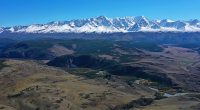The Arctic, once a formidable carbon sink, is now transitioning into a greenhouse gas source.
Over the past few decades, this region has seen unprecedented warming, with temperatures rising twice to four times as fast as the global average.
This rapid warming has led to significant permafrost thaw, increased wildfire occurrences, and dramatic shifts in the landscape.
In March 2024, scientists published findings from a comprehensive study covering greenhouse gas emissions and uptake in the Arctic.
This study, spanning 2000-2020, brought alarming revelations. By analyzing data from over 1,000 flux monitoring sites across various ecosystems, they found that the Arctic permafrost region had emitted a substantial amount of greenhouse gases—approximately 147 million metric tons—in the first two decades of the 21st century.
- Highest CO2 emissions: Inland rivers and wildfires
- Major CH4 sources: Non-permafrost wetlands
- Main N2O emitters: Dry tundra
While initial data suggested the Arctic remained a CO2 sink, uncertainties point to a different narrative—the region is likely closer to being neutral in terms of carbon storage.
The study, however, did not account for subsea permafrost emissions or permafrost in areas like Central Asia and the Tibetan plateau.
Researchers believe that more detailed observational data is essential for accurate greenhouse gas budgets.
This evolving shift from a carbon sink to a source is a concerning development for both the Arctic and global climate.
The El Niño–Antarctic connection
The West Antarctic ice sheet, in contrast to earlier assumptions, is not impervious to climate change. Satellite data reveals a continuous loss of mass in this region. The floating ice shelves, essential in slowing glacial ice flow into the ocean, are also thinning, which contributes to rising sea levels.
A notable influencer of this phenomenon is the El Niño–Southern Oscillation (ENSO). This climatic event, occurring every few years, results in increased surface water temperatures in the central and eastern Pacific Ocean, elevated sea levels, and disrupted global weather patterns.
A 2018 study pointed out that while El Niño events might boost snowfall on ice shelves, the warm waters underneath cause more ice to melt.
Recently, scientists used ocean circulation models to better understand this process.
Lead author Maurice Huguenin highlighted that El Niño has the most significant year-to-year impact on ice shelf melting.
Their research revealed how El Niño conditions lead to the influx of warm circumpolar deep water beneath ice shelves, intensifying basal melting. The reverse occurs during La Niña events, where cooler conditions prevail.
This study provides further evidence that El Niño impacts not just the tropics and temperate zones but also the Antarctic region through atmospheric connections.
When heat waves hit the coldest continent
Global warming has started bringing unexpected weather patterns to Antarctica.
One stark example is the record-breaking heat wave that struck East Antarctica in March 2022.
Temperatures surged up to 40°C (72°F) above normal, an event dubbed a “black swan” due to its rarity and severity.
The heat wave has brought lasting impacts on the region’s ecosystems.
Scientists predict that such high-temperature events will become more common.
The 2022 incident is a testament to how global warming can affect even the most frigid parts of our planet.
These extraordinary temperature spikes disrupt local ecosystems in several ways.
They alter precipitation patterns, accelerate ice melt, and impact wildlife.
The long-term consequences of these heat waves include changes in ice dynamics, potential increases in sea levels, and broader ecosystem disruptions, stressing the need for ongoing climate monitoring and research.









